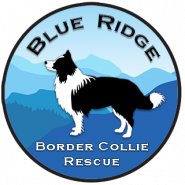STARTING OUT WITH YOUR FOSTER DOG
Foster dogs come to BRBCR from many sources, including shelters, owners who surrender their animals, friends and associates of BRBCR members, and online listings such as BC rescue boards, Petfinder, and Craigslist. BRBCR members may accept dogs into foster care in response to requests on the group’s message board.
Foster parents are not expected to find their own candidates for rescue outside the group, and in fact should not accept dogs on their own initiative. If you become aware of a BC or BC mix in need, feel free to post the information to the group and ask whether BRBCR can help.
Before BRBCR agrees to accept responsibility for a dog, it should be evaluated (see the Dog Evaluation/Intake Form). Either an experienced BRBCR volunteer or another person who is well versed in canine behavior, such as a shelter employee, may perform this evaluation. This task is easier if the owner of the dog is available to give the dog’s history, or if the shelter obtained such a history, though such information is not always complete or accurate.
Evaluation is essential to determining the dog’s suitability for fostering and adoption with minimal risk to all parties involved. BRBCR will not knowingly accept a dog that has acted aggressively toward humans or in most cases toward other animals (see Aggressive Dog Policy).
When a dog becomes available, a message is posted on the Groups.io site asking who might be able to foster him or her. This message will include whatever information is known about the dog and often a picture as well.
You will probably already have thought about what age, gender and temperament of dog is suitable for you, but it’s a good idea to compare these factors to the description of the incoming dog before deciding whether to speak for him or her.
If the dog seems like a good fit, post a message to the Groups.io site in reply to the original request. Transport will need to be arranged (see Transport) unless you live very close to the dog’s location, or unless the dog is being transported by another group that can meet you near your home.
Assuming you have at least one dog of your own, your home is probably dog-proofed already. However, the foster dog may have some behaviors that your own dog does not—for instance, a tendency to chew random objects–so it’s best to look over the areas where the foster dog will be spending time and remove any hazards you may identify. Also, if you will be fostering a puppy, be especially careful in preparing your living space for the new arrival. We strongly recommend crating foster dogs for both their security and comfort and for the peace of mind of the foster parent.
Make sure your own animals are up to date on their vaccinations, including rabies, kennel cough, and DHLPP.
As you would for a new dog of your own, plan to receive the dog when you will be home for at least a day or two, to allow you and the dog a chance to settle in with each other and with other members of the household.
Put a BRBCR tag on the dog as soon as he or she arrives, and if possible use a personal ID tag too. Dogs in new situations do not really know where they are and are more prone to escape when in unfamiliar surroundings. BRBCR tags and a foster package can be obtained by emailing brbcrdogs@gmail.com.
If an incoming dog has a name that seems too long, too silly, or just not suitable, you may change it. Think twice about this, though, if the dog has had this name for some time, as opposed to having been named at a shelter. Ideally the new name will sound somewhat like the old name, to make the transition easier.


